Peter Marcucci
Photos Peter Marcucci and Courtesy Dean Merill
“If you diverge from doing what you love, that may overcome what you love doing. I’d sooner be on the side of the road starving, rather than not do something I love.” —Artist David Sywalski
David Sywalski stood out in the crowd of hundreds at the Acadia Hospital in Bangor, Maine. Both he and I were there to recognize and celebrate the completion of a stone sculpture by our friend Andreas von Huene. After David and I were introduced, he asked if I’d be interested in attending a monthly meeting with his fellow artists. I immediately countered with an offer to do a story on him. David graciously consented. This is his story.
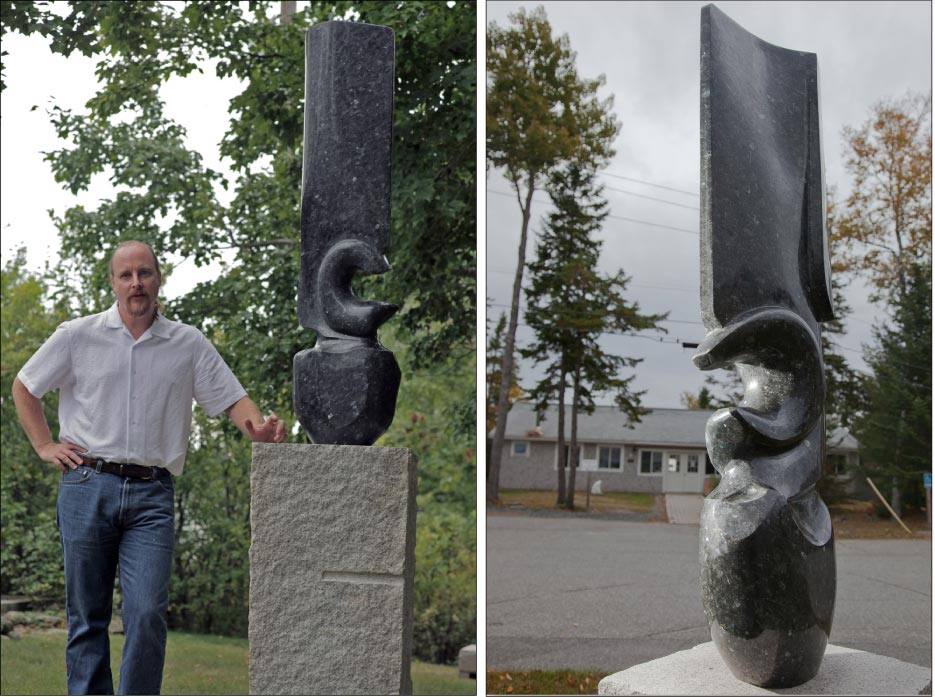 |
|
Totem, Emerald Pearl granite from Norway is 5 feet tall, shown here on display at Turtle Gallery at the left and at the M.D.I. Biological Laboratory on the right.
|
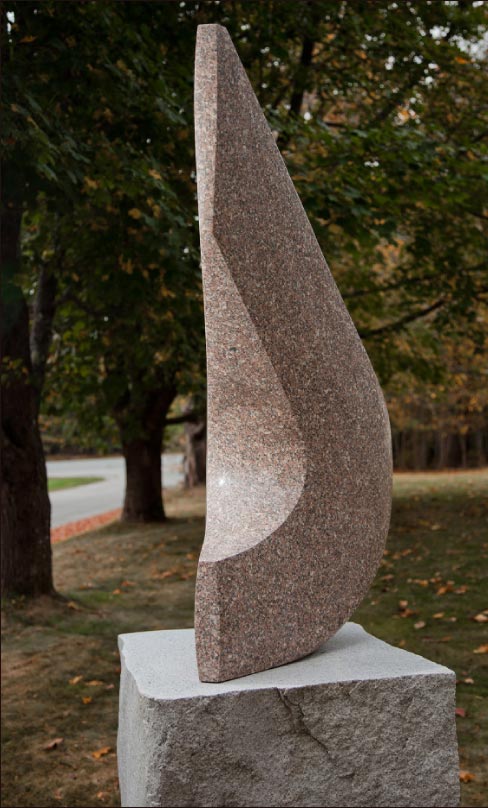 |
|
Above: This Jonesboro Red granite crescent stands 5-1/2 feet tall. Shown at the M.D.I. Biological Laboratory.
|
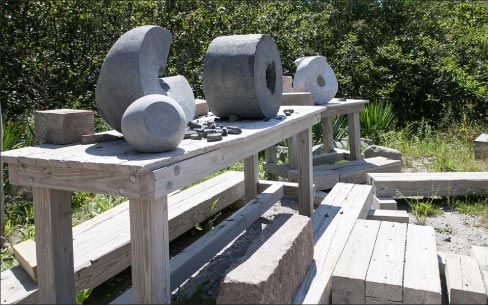 |
|
Above: Sywalski loves carving all shapes and sizes. “A lot of my sculptures are out of my book of jewelry ideas, such as these round sculptures that look like earring designs.”
|
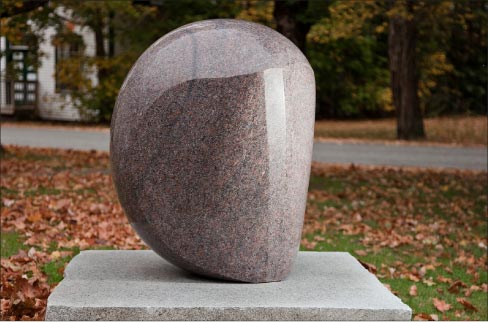 |
|
Above: The Thinker, 2014, carved from Dakota Mahogany granite. Installed at Mount Desert Island Biological Laboratory.
|
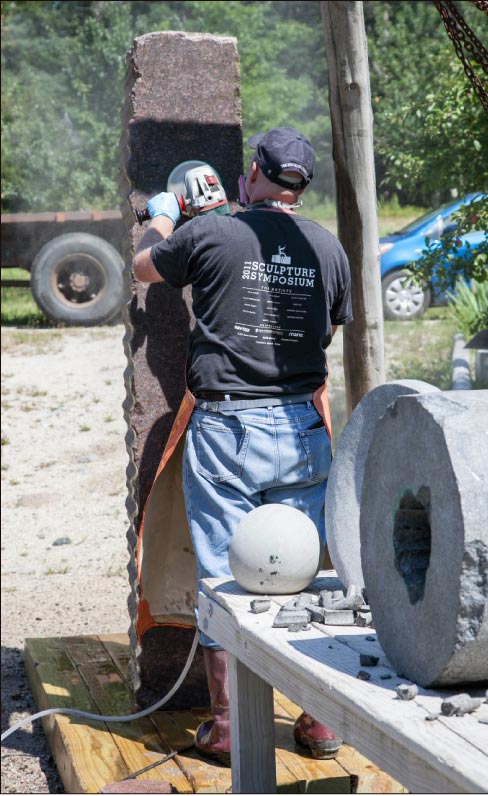 |
|
Above: Sywalski: “I don’t like to leave the evidence of process in my work. My goal is a fully finished and rounded sculpture unimpeded by any visual chatter. That being said, I still have to deal with all processes of the making of art.”
|
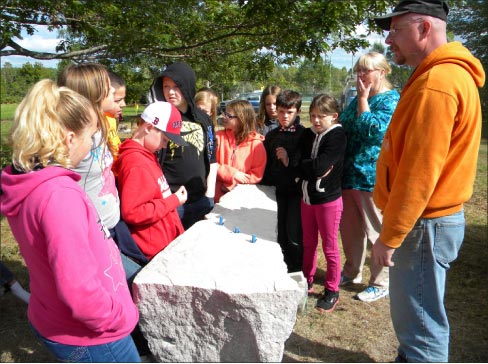 |
|
Above: Sywalski explains his granite carving process to an attentive audience at a symposium.
|
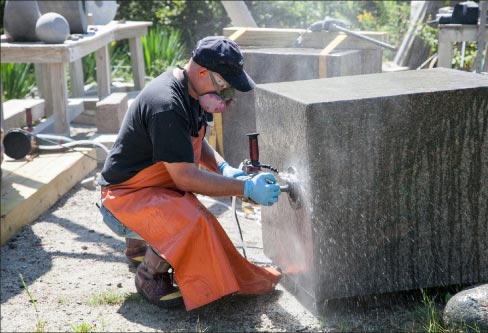 |
|
Above: Wet polishing a Dakota Mahogany cube for a companion piece to The Thinker.
|
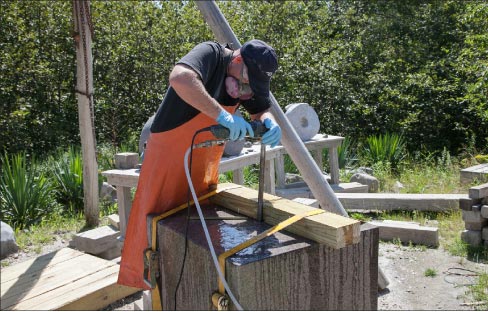 |
|
Above: Sywalski uses a specially adapted 240 volt Metabo CWF.
|
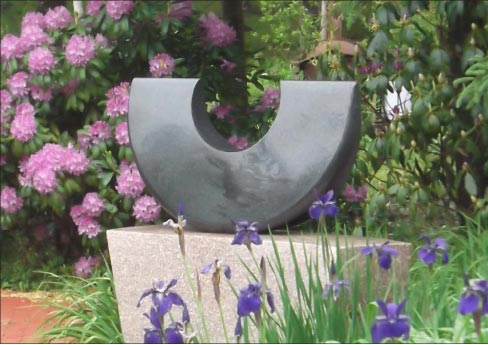 |
|
Black Crescent, 2014, carved from Cambria Black granite.
Photo Courtesy Turtle Gallery
|
At the time of this interview David lived in Trenton, Maine. His studio, an hour away, was located in Cherryfield, Maine. Sywalski was busy prepping tools and supplies for the Viles Arboretum Sculpture Symposium, as well as in the middle of two very special projects using Dakota Mahogany granite.
Sywalski’s love for creating art budded during his early years and blossomed while attending high school in Rochester, New York. “One night I was sitting at my desk at home,” explained Sywalski. “It was a desk my dad and I had made out of an old piano. I was 15 years old, and I sat there and just kept thinking: musician or artist, musician or artist. It was at that time that I actually made a conscious, final decision to continue creating art.”
Sywalski attended Nazareth College in Pittsford, New York, majoring in sculpture and jewelry. During that time he was also working at Albert Paley Studios (a local blacksmith) and continued to work there for a number of years. After graduating Nazareth College, he began doing his own blacksmithing and jewelry, and opened his own company. Soon after, while still in New York, he decided to try carving stone.
A Future in Carving
In 1999, while driving through Round Pond, Maine, Sywalski’s career in stone sculpture had taken a turn for the better, putting him on track for a brilliant future. “I had purchased a bunch of pneumatic carving tools, but didn’t know how to best use them.” he said. “I really had no idea! It was at this time that I found myself on a short vacation in Maine. I was driving down the road and saw this little sign that said: SCULPTURE ARTIST– GRANITE GARDEN SCULPTURE. I just looked at it and thought — Now there’s a visual artist who cannot write a sentence, but knows what he is trying to express, so I stopped and met Don Meserve, a very talented sculptor. That was the turning point for my commitment to carving stone, more specifically, carving Maine quarried granite.
“So I wound up working with Don for nine months. After that, Don continued to provide the support for my carving by allowing me to continue to work out of his studio. He would carve whatever he was doing, and I would carve whatever I was doing, taking tea breaks in between. He really didn’t teach me very much. He just set me up with the hardest granite he could find and said, ‘Do it’! That’s been good in the long run, I think. He also set me up with the hardest tools to use: hammer and chisel. It was awesome!
“So I carved a few pieces, wound up getting a gallery and then attending my first show. The gallery was the Turtle Gallery in Dear Isle, Maine. Elena Kubler, the owner, saw my work, stepped up to the plate and said, ‘Sywalski, show some of your work here.’ Things just ballooned from there. She actually had me curate two shows. It was nice, because I was able to connect the gallery together with fellow sculptors. The first show included Roy Paterson, Dan Ucci and Andreas Von Huene. The next year, she had me curate it again, and at that point there was no reason to leave Maine. Things were going good.”
Sywalski on Sywalski
“Every piece I carve is always my best work at the time. It has got to be. I feel that each artist should always do better within their own work. After all, you are what you do every day. Additionally, I try to continue the field of sculpture, chronologically. Everyone knows that rock and roll came out of the blues. Sculpture has that same type of genealogy. You can say that Rodin started carving through abstract thoughts and ideas, with pieces likening The Thinker and The Kiss. Brancusi studied with Rodin and continued with even more abstraction of the work, and did a beautiful piece of a baby called The Scream. It’s very abstract. You also had Noguchi working a little bit with Brancusi, and coming up with further abstract work. So there is a genealogy there.
“You can cross classify art. Mine is abstract-modern, but I guess the best label, at least for me, would be Post-Minimalism. That would be four good words to describe it. I like to keep a relationship going with all of my works, and I like to think that each piece of sculpture is informed by the previous work. So each piece I do is informing what I do next. I actually think I’ve solved some problems in the minimalist area that other sculptors haven’t solved.
“Scientists work with an abstract theory very creatively when they’re researching an experiment to learn a process. And at the end of that experiment maybe they’ve learned the concrete truth, or maybe not. They’ll then move forward or adjust their original theory.
“As an artist, I deal with tangible material while carving, and get to represent something that’s abstract. And because every single person sees something else in it, that’s actually what makes it abstract. That’s also why I don’t like to title my work.
“As artists we get to deal with concrete truth, and while carving a sculpture and dealing with the material and the cutting and the tools, we also get to represent something that’s abstract.
“In 2014, I made my first sculpture out of Dakota Mahogany, a red granite, for a show at the MDI Biological Laboratory, Mount Dessert Island, Maine. That piece was, for the first time, actually titled. I named it The Thinker because it is in direct reference to Rodin’s The Thinker. I was trying to elevate his work a little bit and bring it past 1920 (the last year of the industrial revolution) with a new version, and not just copy an old version. I believe The Thinker is one of Rodin’s finest pieces, because he was able to carve an abstract idea. You can look at the person sitting there and know that he’s thinking. Every culture can know that he’s thinking. So it does not actually need its title for you to know what it’s about.
“In the past, a sculptor was required to anatomically represent their art, perfectly. That goes for painters and water colorists like botanical painters. Rodin did anatomically perfect work, and then represented that work with thought. As a sculptor, I believe I have a responsibility to continue that evolution of sculpture.
“Sometimes artists recreate The Thinker by simply drawing someone sitting with a balled-up fist. Unfortunately, you don’t get the idea that he is thinking about anything. Instead, he is angry, he has a balled-up fist, and there is tension in there. Sculptors and artists get to represent abstract ideas, and in that fashion we deal in the abstract. In the case of my sculpture at the biology lab, I thought it was suitable for me to carve it for all the scientists who were there thinking all the time.”
Truth in Art = Truth to Self
“Stone carving techniques go back thousands of years,” continued Sywalski. “The Egyptians and Aztecs were splitting stone in much the same way we do today. I don’t like to leave the evidence of process in my work, so my goal is a fully finished and rounded sculpture unimpeded by any visual chatter. I don’t leave split marks in my work and, moreover, don’t need to show the process of how I make everything. That being said, I still have to deal with all of the processes of the making of art. Anyone who is knowledgeable about granite or stone is going to look at my work and know that I split the stone in half, saw cut it or ground it, and it is a representation of every step it took to make that piece.
“I do think it is architectural to leave the rough-cut splits and love it in architectural settings, but when I see a sculpture and the whole surface is left rough and not cleaned up or polished, I think that’s just laziness. When somebody walks up to that piece and sees the drill marks, they’re not seeing the sculpture, they are seeing the drill marks on the sculpture. That’s a big thing to me. Maybe if you cleaned it up you’d have a better sculpture, maybe even more architectural. It’s a lot more work for me, but that’s got to be the way it is.”
Internet Exposure: The Other Word-of-Mouth
Following Sywalski through his shop to the outdoors, I asked, “So why do you do this? Certainly you’re not going to get rich!”
Sywalski put down the tool he was using, and said, “If you display sculptures somewhere, it’s like giving that place a case of wine, and if it doesn’t sell, you take it back — but it’s like they’ve given you back a case of empty wine bottles after they’ve enjoyed that wine! Everybody’s looked at it and enjoyed it, but you’re not paid anything. It’s an interesting dilemma. Obviously, I’m not going to get rich. Sometimes it even costs me money, or I should say my wife and my friends. Fortunately, I have a lot of supportive people around me, and someday, hopefully, I’ll make money. But if I’m not carving, I might as well be dead. That said, I need to further the field of art, so that when I’m dead and gone, people can look back and say, ‘Look at the progress he made in the world of art! Here’s his work, and it was a driving factor.’
“It’s interesting for me to look at other people’s sculptures or paintings, and actually see that there was no direction in their work. It’s puzzling. Art is an exploratory adventure, and you’re exploring new boundaries.
“I’m a typical artist and bad at marketing myself. You can push to fine art collectors and you can find a collector that’s collecting, say, millions of dollars worth of photography, but it’s only color photography or only black and white photography. Or they’re collecting birds, but only wood peckers, or a collector that’s buying modern sculpture, but only modern made of bronze. So unless you’re doing bronze, you’re screwed. It goes on and on. So art collectors seem to be just as specialized as every artist, and weird just like every artist. They almost need to find their own artist and step up to the plate and say, ‘I like that persons work, and I’m going to buy it.’”
The Future
“For years my web designer has been telling me I should do a blog. This year he turned it all on, and now when anybody is doing a search and they type in, ‘granite thinker,’ and up pops my The Thinker, but only because I made a blog entry with it. I also know that success comes from artists supporting artists and making connections with people. Those artists and those people respond to my work and give me advice, and I absorb that while trying to stay focused and enjoy what I’m doing.
“Right now everything is being done on speculation. I kind of like it that way. I learned when I was doing jewelry that sometimes someone would come in wanting a stone set in a ring a certain way. Regretfully, some had to be told that it is really going to look awful when she puts it on. But they’d respond: ‘No, No, No! I want you to do it this way’! So I’d do it. Days later they’d come back and say: ‘Boy, it looked pretty awful when she put it on.’ So I had to cut everything apart and do it over, which I’ve done more than a few times. It’s for this reason I like doing my own work. People can be difficult, and most people are crazy and have a loose shingle or two up there!” he laughed.
“I’ve learned that I can carve animals and birds, but it’s not what I do; although, my wife keeps after me to carve her an elephant. There are wonderful sculptors out there who carve amazing animals, but I’m focused on modern and highly finished sculptures. I’m also thinking of finding a way to produce some of my sculptures in bronze or stainless steel. I have a few more years of carving in me, and I hope that I’ll be able to continue to handle these big tools. When I can’t, maybe I’ll return to jewelry. Time will tell.”
Sywalski currently lives in Arlington, Virginia, with his wife June Devisfruto. His studio is located in Candice, New York, where he continues to engage in the power of expression.
To sample Sywalski’s work visit www.davidsywalski.com .